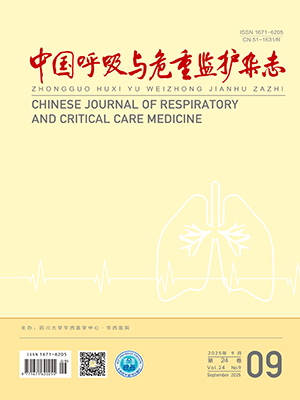| 1. |
World Health Organization. 2021. Classification of omicron (B.1.1.529): SARS-CoV-2 variant of concern[EB/OL]. https://www.who.int/news/item/26-11-2021-classification-of-omicron-(b.1.1.529)-sars-cov-2-variant-of-concern.
|
| 2. |
Hoffmann M, N Krüger, Schulz S, et al. The omicron variant is highly resistant against antibody-mediated neutralization: Implications for control of the COVID-19 pandemic. Cell, 2022, 185(3): 447-456.
|
| 3. |
Zhang PX, Yang SH, Dai SQ, et al. Global spreading of omicron variant of COVID-19. Geospat Health, 2022, 17(s1): 1083.
|
| 4. |
World Health Organization. 2021. Update on omicron. https://www.who.int/news/item/28-11-2021-update-on-omicron.
|
| 5. |
Chen ZY, Deng XW, Fang LQ, et al. Epidemiological characteristics and transmission dynamics of the outbreak caused by the SARS-CoV-2 Omicron variant in Shanghai, China: a descriptive study[EB/OL]. medRxiv [Preprint]. [2022-06-18]. https://www.medrxiv.org/content/10.1101/2022.06.11.22276273v1. Update in: Lancet Reg Health West Pac, 2022, 29: 100592.
|
| 6. |
Shao JS, Fan R, Hu JR, et al. Clinical progression and outcome of hospitalized patients infected with SARS-CoV-2 omicron variant in Shanghai, China. Vaccines (Basel), 2022, 10(9): 1409.
|
| 7. |
徐湘茹, 孙鼎, 曹敏, 等. 上海市4 264例无症状及轻型新冠病毒感染者临床特征及预后转归分析. 中华危重病急救医学, 2022, 34(5): 449-453.
|
| 8. |
Nyberg T, Ferguson NM, Nash SG, et al. Comparative analysis of the risks of hospitalisation and death associated with SARS-CoV-2 omicron (B.1.1.529) and delta (B.1.617.2) variants in England: a cohort study. Lancet, 2022, 399(10332): 1303-1312.
|
| 9. |
Maslo C, Friedland R, Toubkin M, et al. Characteristics and outcomes of hospitalized patients in South Africa during the COVID-19 omicron wave compared with previous waves. JAMA, 2022, 327(6): 583-584.
|
| 10. |
World Health Organization. TAG-VE statement on the meeting of 3 January on the COVID-19 situation in China[EB/OL]. https://www.who.int/news/item/04-01-2023-tag-ve-statement-on-the-3rd-january-meeting-on-the-covid-19-situation-in-china.
|
| 11. |
Guan WJ, Ni ZY, Hu Y, et al. China Medical Treatment Expert Group for Covid-19. Clinical characteristics of coronavirus disease 2019 in China. N Engl J Med, 2020, 382(18): 1708-1720.
|
| 12. |
Huang R, Zhu L, Xue LY, et al. Clinical and virological course of patients with coronavirus disease 2019 in Jiangsu province, China: a retrospective, multi-center cohort study. Virol J, 2021, 18(1): 147.
|
| 13. |
Paderno A, Schreiber A, Grammatica A, et al. Smell and taste alterations in COVID-19: a cross-sectional analysis of different cohorts. Int Forum Allergy Rhinol, 2020, 10(8): 955-962.
|
| 14. |
Lechien JR, Chiesa-Estomba CM, De Siati DR, et al. Olfactory and gustatory dysfunctions as a clinical presentation of mild-to-moderate forms of the coronavirus disease (COVID-19): a multicenter European study. Eur Arch Otorhinolaryngol, 2020, 277(8): 2251-2261.
|
| 15. |
Hannum ME, Koch RJ, Ramirez VA, et al. Taste loss as a distinct symptom of COVID-19: a systematic review and meta-analysis[EB/OL]. medRxiv [Preprint]. [2021-10-09]. https://www.medrxiv.org/content/10.1101/2021.10.09.21264771v1. Update in: Chem Senses, 2022, 47: bjac001.
|
| 16. |
Meo SA, Meo AS, Al-Jassir FF, et al. Omicron SARS-CoV-2 new variant: global prevalence and biological and clinical characteristics. Eur Rev Med Pharmacol Sci, 2021, 25(24): 8012-8018.
|
| 17. |
Dhama K, Nainu F, Frediansyah A, et al. Global emerging omicron variant of SARS-CoV-2: impacts, challenges and strategies. J Infect Public Health, 2023, 16(1): 4-14.
|
| 18. |
Cedro-Tanda A, Gómez-Romero L, de Anda-Jauregui G, et al. Early genomic, epidemiological, and clinical description of the SARS-CoV-2 omicron variant in Mexico City. Viruses, 2022, 14(3): 545.
|
| 19. |
Piersiala K, Kakabas L, Bruckova A, et al. Acute odynophagia: a new symptom of COVID-19 during the SARS-CoV-2 omicron variant wave in Sweden. J Intern Med, 2022, 292(1): 154-161.
|
| 20. |
Halfmann PJ, Iida S, Iwatsuki-Horimoto K, et al. SARS-CoV-2 omicron virus causes attenuated disease in mice and hamsters. Nature, 2022, 603(7902): 687-692.
|




